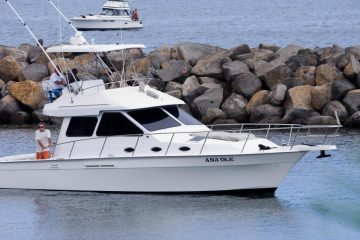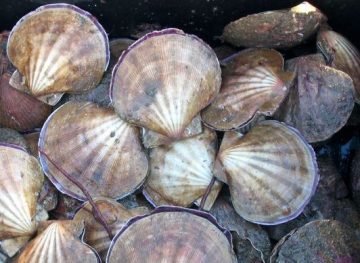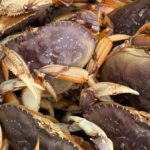Daily Archives: October 21, 2016

Photo Release: Coast Guard tows disabled fishing vessel to Dutch Harbor, Alaska
Petty Officer 3rd Class Kevin Hedman, a gunners mate aboard Coast Guard Cutter Morgenthau, shoots a tow line to fishing vessel Pacific Sounder near Cold Bay, Alaska, Oct. 20, 2016. The Pacific Sounder lost propulsion and requested Coast Guard assistance. The Pacific Sounder lost propulsion and requested Coast Guard assistance. Click here for more photos 18:26

On bottom in Grand Passage – boat and barge troubles near Brier and Long Islands
People are having trouble keeping their boats afloat around Brier and Long Islands this week. An aquaculture barge sank in Westport Harbour Oct. 19 and then a lobster boat went aground Oct. 21. A small feed barge at the Cooke Aquaculture site near Westport spent a day on the bottom before it could be towed to shore Oct. 20. And then the fishing boat the Atlantic Conquest somehow ended up high and dry on the Cow Ledge, a shoal on the Long Island side of the northern end of Grand Passage. More images, read the rest here 16:29:41
American Somoa misses out on quota transfer fisheries revenues
 Statements by the governor’s fisheries advisor at the meeting of the Western Pacific Fishery Management Council last week indicate that the territory missed out on an opportunity to earn money from allowing Hawaii to use our quota of big eye tuna catch. During the public comment session which followed a report on American Samoa’s fisheries activities at the Council meeting in Honolulu, Governor Lolo’s adviser on fisheries, Vaamua Henry Sesepasara, spoke up about the big eye quota transfer. This allows Hawaii longliners to buy unused quota limits for big eye catch of the territories of Guam, Northern Marianas and American Samoa. Vaamua said that the Lolo administration was not aware of the big eye quota transfer which was first carried out in 2011 and 2012 under the Togiola administration. Read the story here 14:12
Statements by the governor’s fisheries advisor at the meeting of the Western Pacific Fishery Management Council last week indicate that the territory missed out on an opportunity to earn money from allowing Hawaii to use our quota of big eye tuna catch. During the public comment session which followed a report on American Samoa’s fisheries activities at the Council meeting in Honolulu, Governor Lolo’s adviser on fisheries, Vaamua Henry Sesepasara, spoke up about the big eye quota transfer. This allows Hawaii longliners to buy unused quota limits for big eye catch of the territories of Guam, Northern Marianas and American Samoa. Vaamua said that the Lolo administration was not aware of the big eye quota transfer which was first carried out in 2011 and 2012 under the Togiola administration. Read the story here 14:12
State Medical Examiner investigates apparent drug overdose on New Bedford fishing boat
 State and local police are investigating the apparent fatal overdose of a man, who was found unresponsive on a fishing boat docked at Pier 3 in New Bedford. The 49-year-old Fairhaven man was pronounced dead at St. Luke’s Hospital Thursday night after being found on the fishing vessel Saint Jude. The death appears to be an overdose, police said, but the state’s medical examiner was investigating. Signs of drug use were found. A co-worker on the boat attempted CPR before police, fire and EMS arrived at about 8:38 p.m. The victim was transported to St. Luke’s Hospital, where he was pronounced dead at 10:05 p.m. The is investigating, along with New Bedford Police and State Police. Link 13:02
State and local police are investigating the apparent fatal overdose of a man, who was found unresponsive on a fishing boat docked at Pier 3 in New Bedford. The 49-year-old Fairhaven man was pronounced dead at St. Luke’s Hospital Thursday night after being found on the fishing vessel Saint Jude. The death appears to be an overdose, police said, but the state’s medical examiner was investigating. Signs of drug use were found. A co-worker on the boat attempted CPR before police, fire and EMS arrived at about 8:38 p.m. The victim was transported to St. Luke’s Hospital, where he was pronounced dead at 10:05 p.m. The is investigating, along with New Bedford Police and State Police. Link 13:02
Gulf of Mexico shrimp landings low, prices up
 Shrimp landings in the Gulf of Mexico are running lower than usual, but prices are up, according to the latest data issued by the National Oceanographic and Atmospheric Administration (NOAA). U.S. shrimpers caught 11.2 million lbs. of shrimp in September 2016, the lowest September total since 2008 and 3.5 million fewer lbs. than was caught last September. The total is nearly 18 percent off the 14-year historical catch average of 13.6 million lbs. Landings in the U.S. states of Texas and Alabama both fell markedly, while Louisiana’s catch was around its historical average for September. Texan shrimpers caught 4.3 million lbs. of shrimp in September, Read the rest here 11:43
Shrimp landings in the Gulf of Mexico are running lower than usual, but prices are up, according to the latest data issued by the National Oceanographic and Atmospheric Administration (NOAA). U.S. shrimpers caught 11.2 million lbs. of shrimp in September 2016, the lowest September total since 2008 and 3.5 million fewer lbs. than was caught last September. The total is nearly 18 percent off the 14-year historical catch average of 13.6 million lbs. Landings in the U.S. states of Texas and Alabama both fell markedly, while Louisiana’s catch was around its historical average for September. Texan shrimpers caught 4.3 million lbs. of shrimp in September, Read the rest here 11:43
Recreational Fishing Industry report seeks federal fisheries reform
 Several stakeholders in the recreational fishing and boating industries released a set of recommendations for the incoming administration and Congress to change the way federal overseers allocate saltwater fish. The Center for Coastal Conservation and its 10 member groups issued a report recommending a government shift away from using the same tools to manage commercial fisheries as it does for recreational fishing at a federal level. “One of the most important things in the document we put forward is the recommendation that we get our own Recreational Fishing Advisory Committee,” Center for Coastal Conservation president Jeff Angers told Trade Only Today. “The current Marine Fisheries Advisory Committee is dominated by the commercial industry. We really need our own. We have a different industry, different constituents, different environmental impacts.” Read the rest here 11:07
Several stakeholders in the recreational fishing and boating industries released a set of recommendations for the incoming administration and Congress to change the way federal overseers allocate saltwater fish. The Center for Coastal Conservation and its 10 member groups issued a report recommending a government shift away from using the same tools to manage commercial fisheries as it does for recreational fishing at a federal level. “One of the most important things in the document we put forward is the recommendation that we get our own Recreational Fishing Advisory Committee,” Center for Coastal Conservation president Jeff Angers told Trade Only Today. “The current Marine Fisheries Advisory Committee is dominated by the commercial industry. We really need our own. We have a different industry, different constituents, different environmental impacts.” Read the rest here 11:07
Tasmanian researchers say Scallop deaths linked to seismic surveys being carried out on seabed
 A link can be drawn between seismic testing for mineral resources and scallop deaths, Tasmanian researchers say. The Fisheries Research and Development Corporation has released findings of a four-year study into the impact of marine seismic surveys on south-east Australian lobster and scallop populations. The study began after Tasmanian fisherman were convinced seismic testing carried out by the Victorian Government in Bass Strait in 2010 caused a massive die-off. Seismic testing involves firing soundwaves into the ocean floor to detect the presence of oil or gas reserves. Bridport fisherman Allan Barnett was hit hard from the 2010 mass mortality. “The industry blames the seismic activity for the death of virtually all the scallops in that bed which was 24,000 tonne — about $70 million worth,” he said. Read the story here 10:24
A link can be drawn between seismic testing for mineral resources and scallop deaths, Tasmanian researchers say. The Fisheries Research and Development Corporation has released findings of a four-year study into the impact of marine seismic surveys on south-east Australian lobster and scallop populations. The study began after Tasmanian fisherman were convinced seismic testing carried out by the Victorian Government in Bass Strait in 2010 caused a massive die-off. Seismic testing involves firing soundwaves into the ocean floor to detect the presence of oil or gas reserves. Bridport fisherman Allan Barnett was hit hard from the 2010 mass mortality. “The industry blames the seismic activity for the death of virtually all the scallops in that bed which was 24,000 tonne — about $70 million worth,” he said. Read the story here 10:24
Bait crisis is over, but Maine lobstermen are still feeling the pinch
 The lobster bait crisis that plagued New England this summer is finally over, now that fishermen have begun to catch herring off Georges Bank. But the price of lobstermen’s favorite bait fish, which rose dramatically when the offshore fleet wasn’t landing enough herring to refill empty bait freezers, has remained high through the end of peak lobster season, typically August through late October. Although there’s been no appreciable effect on consumer prices, lobstermen agree the shortage hurt their bottom line. “There is always a risk of something like this in a wild-caught fishery,” Patrice McCarron said. “You can’t create supply. Herring just wasn’t available, and no manager can fix that. I think the managers did the best they could to stretch the inshore bait out as long as they did, but there’s no doubt, it cost us more than ever to bait our traps this year.” Read the story here 09:33
The lobster bait crisis that plagued New England this summer is finally over, now that fishermen have begun to catch herring off Georges Bank. But the price of lobstermen’s favorite bait fish, which rose dramatically when the offshore fleet wasn’t landing enough herring to refill empty bait freezers, has remained high through the end of peak lobster season, typically August through late October. Although there’s been no appreciable effect on consumer prices, lobstermen agree the shortage hurt their bottom line. “There is always a risk of something like this in a wild-caught fishery,” Patrice McCarron said. “You can’t create supply. Herring just wasn’t available, and no manager can fix that. I think the managers did the best they could to stretch the inshore bait out as long as they did, but there’s no doubt, it cost us more than ever to bait our traps this year.” Read the story here 09:33

U.S. Customs and Border Protection: Foreign Fishermen Have No Complaints Working On US longline vessels
Federal officials said Thursday they have interviewed dozens of foreign crew members who work on U.S. commercial fishing boats since allegations of labor abuses surfaced, but haven’t found much beyond a few cockroaches. “They had an opportunity to talk to us freely,” said Ferdie Jose, supervisory officer for the U.S. Customs and Border Protection. “They didn’t voice any complaints.” Jose made the statement at what has traditionally been a private quarterly meeting among commercial fishing vessel owners, law enforcement officers and state and federal officials. It was a marked contrast to one held just a day earlier at the state Capitol, where legislators grilled state officials and fishing industry leaders for nearly three hours in an effort to find ways to improve the working conditions for foreign crew members. Read the story here 09:02

Destroyed tuna vessel Laurie Ann towed to Salisbury
The Laurie Ann, a 35-foot-long tuna boat that sank in the mouth of the Merrimack River Monday evening in rough seas, is back above water but its days as a seaworthy vessel appear to be over. Wednesday evening the vessel was towed back to shore and hauled out by a TowBoatUS crew, an operation that took roughly six hours. Afterward, the boat was trucked to the Salisbury Industrial Park off Rabbit Road where its owner, Stan Kench, works, according to Mike Goodridge of TowBoatUS. Kench was one of two men onboard the vessel when it capsized in choppy water around 7 p.m. Monday. Both men were thrown from the boat and sustained minor injuries. The capsizing was witnessed by a good Samaritan aboard the Lady Suzanne who radioed the Coast Guard for help and then plucked the two men from the water. Read the story here 08:36













































